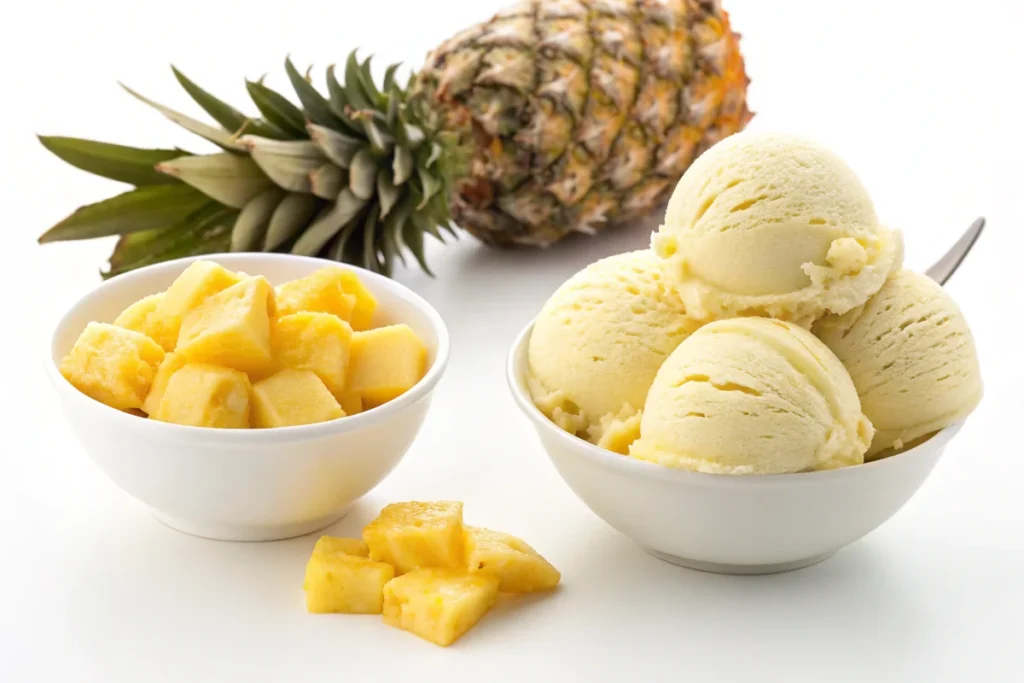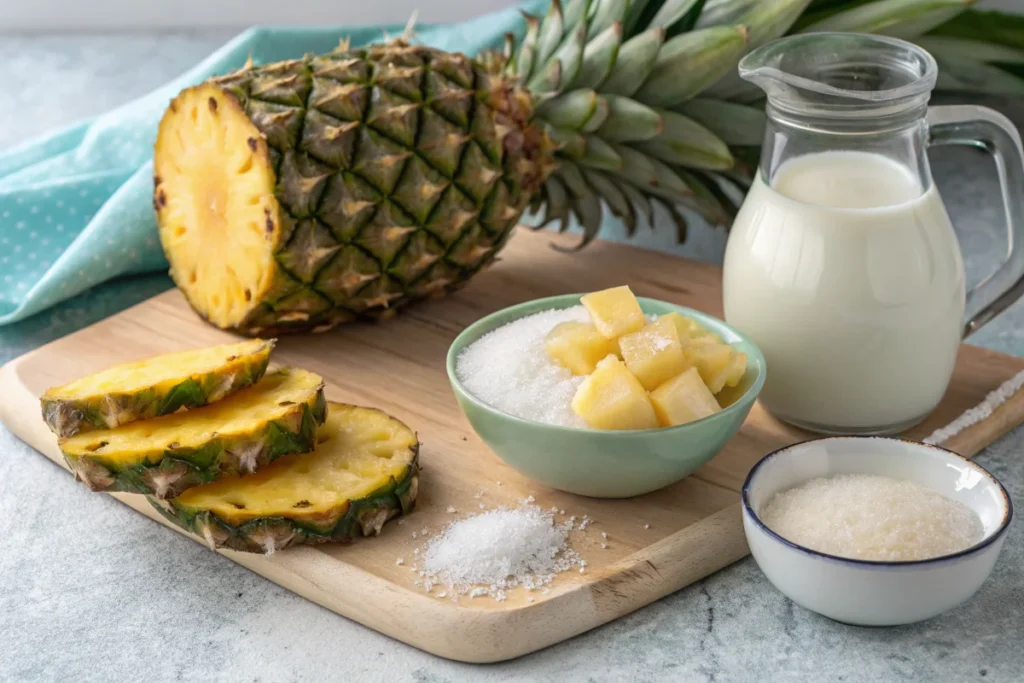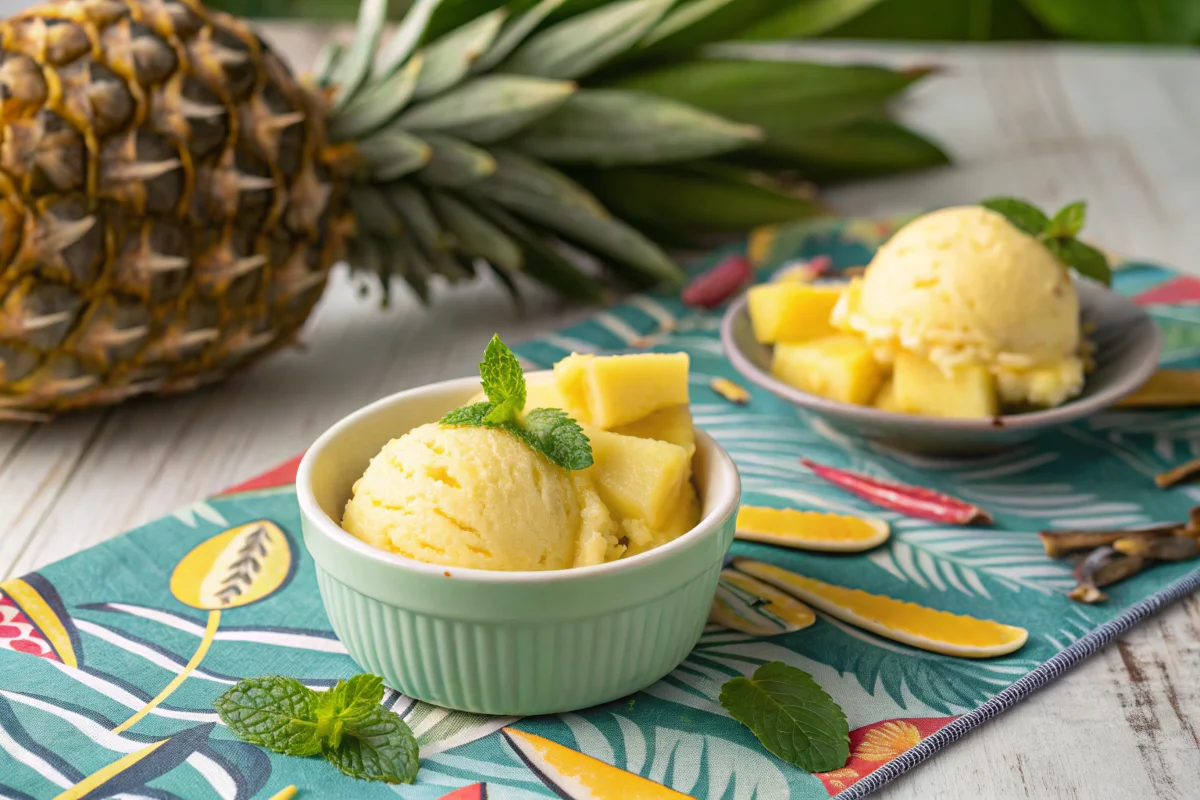Pineapple sherbet is a delightful frozen dessert that perfectly balances the tangy sweetness of pineapple with the creamy texture of sherbet. It is a refreshing treat enjoyed by people of all ages around the world. But what exactly is pineapple sherbet, and how did it become so popular?
The history of frozen desserts dates back centuries, with various cultures contributing to their evolution. For example, ancient civilizations enjoyed crushed ice mixed with fruit juices. Similarly, the story of pineapple sherbet is just as fascinating. Sherbet has evolved over time, changing from a simple icy refreshment to a sophisticated dessert that brings together diverse cultural influences. Pineapple, with its distinctive sweet and tart flavor, became a star ingredient in many dessert recipes, and pineapple sherbet is no exception.
Pineapple itself has a rich history, originating from South America and spreading globally due to its unique flavor and health benefits. Cultivated by the Tupi-Guarani people, pineapples were introduced to Europe by Christopher Columbus in the 15th century. From there, it gained immense popularity due to its exotic taste and versatility. Pineapples are packed with nutrients, making pineapple sherbet not only tasty but also beneficial for your health.
The History of Pineapple Sherbet
Origin of Sherbet
Sherbet, often confused with sorbet, has a storied past that dates back to the Middle East, where it was originally a sweet, chilled drink. Over time, it evolved into the frozen dessert we know today. Sherbet traditionally contains fruit juice, sugar, and a small amount of dairy, giving it a creamy texture that’s lighter than ice cream. As it spread across Europe and eventually to America, sherbet adapted to local ingredients and preferences. In the United States, sherbet became a favorite during the 19th century, with pineapple being one of the most beloved flavors.
How Pineapple Became a Popular Flavor
Pineapple’s exotic taste made it a sought-after fruit since its discovery. As global trade expanded, pineapples became more accessible, and their incorporation into desserts like sherbet was a natural progression. Pineapple sherbet combines the fruit’s tropical flavor with the smoothness of sherbet, creating a unique dessert experience. By the 20th century, canned pineapple became widely available, making it easier for home cooks to experiment with pineapple in desserts, further boosting its popularity.
Cultural Significance
In many cultures, pineapples symbolize hospitality and warmth. Therefore, serving pineapple sherbet can be a welcoming gesture to guests. It is often featured in festive occasions and summer gatherings, highlighting its role in social traditions. For instance, in the United States, pineapples are often used as a decorative centerpiece at parties, signifying a warm welcome. Pineapple sherbet, with its bright, cheerful flavor, embodies this spirit of hospitality.
In tropical regions, pineapples are associated with abundance and celebration. Pineapple sherbet’s popularity at social events and its refreshing taste make it an ideal dessert for outdoor barbecues, pool parties, and other festive gatherings. Its vibrant color and fresh taste make it a crowd-pleaser, perfect for both adults and children.
What Is Pineapple Sherbet Made Of?
Pineapple sherbet is primarily made of fresh pineapple juice or puree, sugar, water, and dairy such as milk or cream. Some recipes include egg whites for texture. The dairy component differentiates sherbet from sorbet, providing a creamier consistency. The combination of dairy and fruit juice creates a balance between sweetness and creaminess that is characteristic of sherbet.
The inclusion of natural pineapple offers nutritional benefits, including vitamin C and bromelain, an enzyme known for its anti-inflammatory properties. Bromelain aids digestion and reduces swelling, providing numerous health benefits. Therefore, pineapple sherbet isn’t just a treat; it also has healthful properties that make it a better option compared to many other desserts.
Pineapple Sherbet vs. Pineapple Sorbet

Defining Sherbet and Sorbet
At first glance, sherbet and sorbet might seem similar, but they have distinct differences. Sorbet is a frozen dessert made from sweetened water and fruit juice or puree, without any dairy. On the other hand, sherbet includes a small amount of dairy, which gives it a creamier texture. This dairy content is what sets sherbet apart, offering a unique mouthfeel that is both smooth and light.
How Is Sherbet Different Than Sorbet?
The primary difference between sherbet and sorbet lies in their ingredients. As mentioned earlier, sherbet contains dairy, while sorbet does not. This means pineapple sherbet is creamier and has a slightly richer taste compared to pineapple sorbet, which is lighter and more icy. Sorbet, however, is often preferred by those looking for a dairy-free or vegan option. Sherbet’s consistency makes it more filling, while sorbet often serves as a palate cleanser between courses.
Sherbet typically has a lower fat content compared to ice cream, but it is creamier than sorbet due to the presence of dairy. This middle ground makes sherbet a versatile dessert option, perfect for those who want something less indulgent than ice cream but more substantial than sorbet.
Is Pineapple Sherbet Good?
Absolutely! Pineapple sherbet is not only delicious but also offers a refreshing dessert option that’s perfect for warm weather. The combination of sweet and tangy flavors makes it appealing to a wide range of taste preferences. Its bright color and fruity flavor can bring a taste of the tropics to any occasion, making it a great choice for entertaining or simply indulging yourself.
Pineapple sherbet can be a healthier alternative to heavier desserts like ice cream. Because it contains real fruit and less fat, it’s a guilt-free indulgence. Real fruit content provides vitamins, especially vitamin C, which helps boost the immune system. So, not only does pineapple sherbet satisfy your sweet tooth, but it also provides some health benefits.
Pineapple sherbet is versatile—it can be enjoyed on its own, used as a topping for fruit salads, or even served as a palate refresher between savory courses. Its unique flavor pairs well with a variety of dishes, enhancing the overall dining experience. Whether you’re hosting a summer barbecue or looking for a light dessert after a hearty meal, pineapple sherbet is an excellent choice.
Health Benefits of Pineapple Sherbet
Nutritional Content
Pineapple sherbet provides essential nutrients from pineapple, including vitamin C, manganese, and dietary fiber. It is lower in fat compared to traditional ice cream, making it a lighter dessert option. Vitamin C is a powerful antioxidant that helps protect cells from damage and supports immune function. Manganese, found in pineapple, is essential for bone health and metabolism.
Benefits of Pineapple
Pineapple is known for its anti-inflammatory properties due to bromelain. Therefore, consuming pineapple sherbet can contribute to digestive health and immune support. Studies show that bromelain can reduce inflammation, particularly in conditions like sinusitis and arthritis. This makes pineapple sherbet not only a refreshing treat but potentially beneficial for those dealing with chronic inflammation.
Pineapple contains antioxidants that combat oxidative stress, which can help reduce the risk of chronic diseases. These antioxidants also promote skin health, giving you an extra reason to enjoy pineapple sherbet. With its vitamin-rich profile, pineapple sherbet offers more than just flavor—it provides nutrients that support overall well-being.
Low-Fat Dessert Option
Compared to other frozen desserts, pineapple sherbet has less fat and fewer calories. As a result, it’s suitable for those watching their calorie intake but still wanting to enjoy a sweet treat. For individuals who want to cut down on their fat consumption, pineapple sherbet offers a delicious alternative that doesn’t compromise on taste. The natural sweetness of pineapple sherbet makes it a great choice for satisfying cravings without guilt.
Pineapple sherbet is lower in saturated fat than ice cream, making it a heart-healthy option. The fruit content also adds natural sugars, which can be a healthier alternative to artificial sweeteners often found in other desserts. Thus, choosing pineapple sherbet can be a step towards a more balanced diet, especially when you want something sweet.
How to Make Homemade Pineapple Sherbet

Ingredients Needed
- 2 cups of fresh pineapple chunks
- 1 cup of sugar
- 1 cup of water
- 1 cup of milk or cream
- Juice of one lemon
For those seeking a healthier version, you can reduce the sugar or replace it with natural sweeteners like honey or agave nectar. Using fresh pineapple will also enhance the natural flavor and reduce the need for additional sweeteners.
Step-by-Step Recipe
- First, combine sugar and water in a saucepan to create a simple syrup. Heat until the sugar dissolves completely. Stir constantly to ensure the sugar does not burn or caramelize.
- Next, blend the pineapple chunks until smooth. Make sure there are no large chunks remaining, as they can affect the texture of the sherbet.
- Then, mix the pineapple puree, simple syrup, milk or cream, and lemon juice in a bowl. The lemon juice adds a hint of acidity that enhances the pineapple flavor and balances the sweetness.
- Pour the mixture into an ice cream maker and churn according to the manufacturer’s instructions. Churning incorporates air, which gives the sherbet a light, fluffy texture.
- Finally, transfer the sherbet to a container and freeze for at least 4 hours before serving. For best results, cover the surface of the sherbet with plastic wrap to prevent ice crystals from forming.
Tips and Variations
- For a dairy-free option, substitute milk with coconut milk. This substitution will give the sherbet a more tropical flavor, complementing the pineapple.
- To add a twist, include a splash of rum for an adult version. This addition can create a piña colada-inspired flavor that’s perfect for summer gatherings.
- Garnish with mint leaves or pineapple slices when serving. Garnishes add visual appeal and enhance the dessert’s freshness.
You can also experiment with other tropical fruits like mango or passionfruit to create unique flavor combinations. For a creamier texture, try adding a small amount of coconut cream along with the milk.
What Is Pineapple Sorbet Made Of?
Pineapple sorbet is made of pineapple juice or puree, sugar, and water. Because it lacks dairy, the texture is lighter and more icy than sherbet. It is suitable for vegans and those with lactose intolerance. Sorbet is particularly refreshing on a hot day, offering a burst of pineapple flavor without the creaminess of sherbet.
Pineapple sorbet can be a great base for creative dessert ideas. For instance, you can use it as a topping for sparkling wine to create a light, fruity cocktail. Alternatively, pair it with a scoop of coconut ice cream for a tropical dessert duo.
Serving Suggestions and Pairings
Best Ways to Serve Pineapple Sherbet
- Serve in a chilled bowl or glass for optimal freshness. Keeping the serving dish cold helps maintain the sherbet’s texture, especially on a warm day.
- Add a scoop to sparkling water for a refreshing float. This simple twist turns the sherbet into a delightful drink, perfect for cooling down during the summer.
- Pair with fresh fruit for a healthy dessert option. Combining it with fruits like berries or mango adds extra flavor and color, making it a visually appealing treat.
Complementary Dishes and Drinks
- Pair with coconut desserts for a tropical theme. Coconut macaroons or coconut cake complement the pineapple flavor perfectly, creating a cohesive dessert experience.
- Serve alongside grilled meats to cleanse the palate. The acidity of the pineapple helps cut through the richness of the meat, providing a refreshing contrast.
- Enjoy with a glass of white wine or champagne. Sherbet’s lightness pairs well with sparkling drinks, enhancing the dining experience.
Pineapple sherbet can also be served as a palate cleanser during multi-course meals. Its tartness helps to refresh the taste buds, preparing guests for the next course.
Vegan and Dairy-Free Alternatives
How to Make Vegan Pineapple Sherbet
To make a vegan version, replace dairy with plant-based milk alternatives like coconut milk or almond milk. Ensure all other ingredients are vegan-friendly. The use of coconut milk adds an extra layer of tropical flavor, enhancing the pineapple taste.
Alternative Ingredients
- Coconut milk for a tropical twist. This option adds a creamy texture that complements the pineapple’s acidity.
- Cashew milk for a creamy texture. Cashew milk has a neutral flavor that blends well with pineapple, providing creaminess without overpowering the fruit.
- Agave nectar instead of sugar for a natural sweetener. Agave nectar is less processed and has a lower glycemic index than refined sugar, making it a healthier alternative.
Using these alternatives, you can create a vegan pineapple sherbet that is just as creamy and flavorful as the traditional version. Experimenting with different plant-based milks can yield unique flavors and textures, giving you a variety of options to enjoy.
Frequently Asked Questions
What Is Pineapple Sherbet Made Of?
Pineapple sherbet is made of pineapple juice or puree, sugar, water, and a small amount of dairy like milk or cream. This combination gives it a creamy texture distinct from sorbet. Dairy sets sherbet apart from sorbet, giving it a richer mouthfeel.
How Is Sherbet Different Than Sorbet?
Sherbet includes dairy, while sorbet does not. Therefore, sherbet is creamier, and sorbet is lighter and more icy. Dairy in sherbet creates a smoother texture, while sorbet’s dairy-free composition makes it crisp and refreshing.
Is Pineapple Sherbet Good?
Yes, pineapple sherbet is delicious and refreshing. In addition, it’s a healthier alternative to heavier desserts, offering nutritional benefits from real pineapple. Its balance of creaminess and fruitiness makes it a versatile dessert suitable for various occasions.
What Is Pineapple Sorbet Made Of?
Pineapple sorbet is made from pineapple juice or puree, sugar, and water, without any dairy. As a result, it’s suitable for vegans and those with lactose intolerance. The absence of dairy gives it a lighter texture, making it an ideal choice for those seeking a refreshing, fruity dessert.
Conclusion
Pineapple sherbet is a delightful dessert that combines the tropical flavor of pineapple with the creamy texture of sherbet. Whether you make it at home or buy it from a store, it’s a refreshing treat that’s perfect for any occasion. So, why not try making your own pineapple sherbet today? With its vibrant flavor and smooth texture, pineapple sherbet is sure to be a hit, bringing a touch of the tropics to your table. Whether you’re hosting a summer party or simply want to treat yourself, this delicious dessert is an excellent choice that offers both flavor and nutrition.

